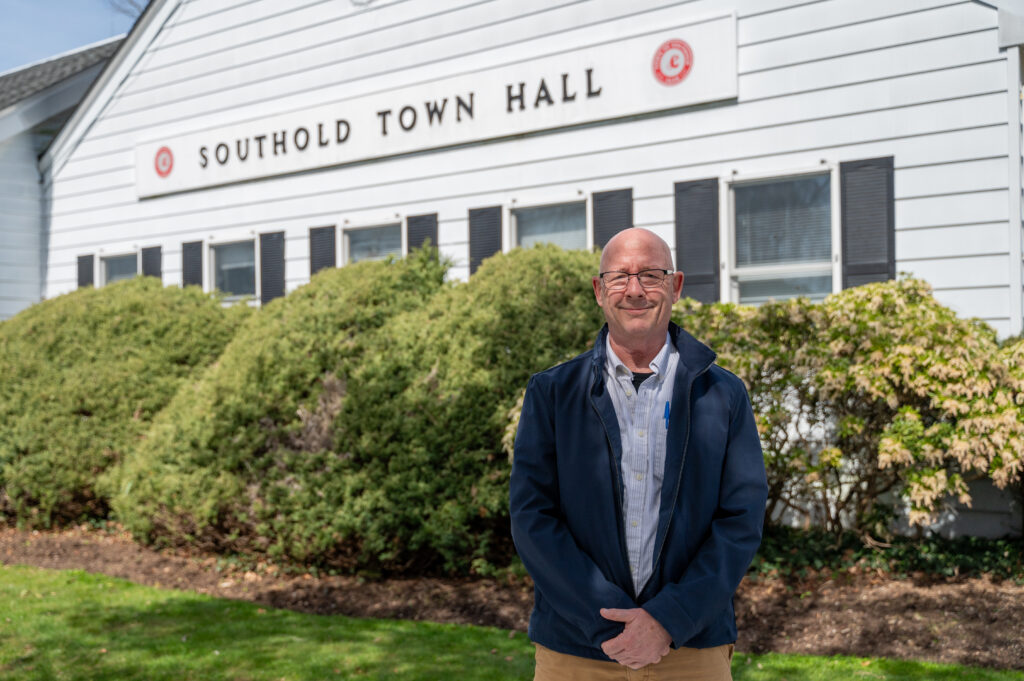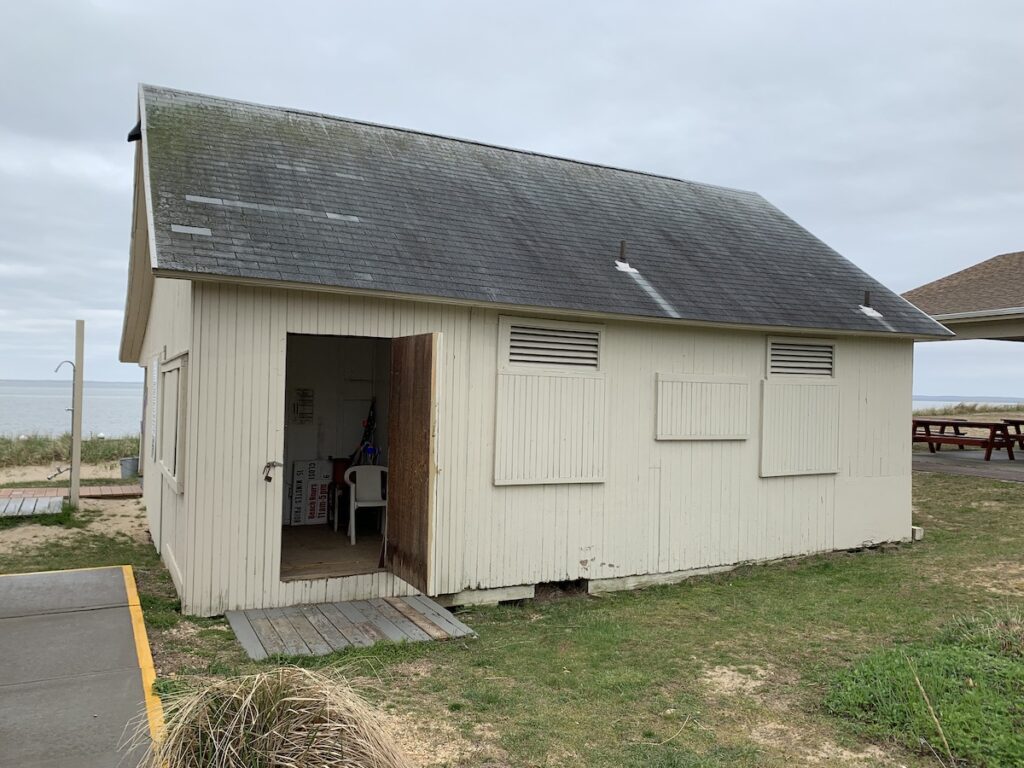Greenport Village Board shares its vision

Nearly three months after a new mayor and two new trustees took office, Greenport’s Village Board presented the community with an executive summary of the state of the village — a data-driven snapshot of how things are now, and what to do next.
Last Thursday’s meeting was the second of two “Vision for Greenport” sessions this summer that sought to foster an ongoing dialogue between residents and village officials outside the formality of public board meetings.
Mayor Kevin Stuessi said the sessions are helping to form a consensus on “what we need to do to protect what’s important to us, as well as manage growth smartly.”
Trustee Lily Dougherty-Johnson, head of the village communications department, began the presentation with a look at the village by the numbers. She said the 2020 census for Greenport counted roughly 2,500 residents, higher than the projected 2023 figure of 2,000, reflecting a potential loss of at least 500 full-time residents. She said there are 10 hotels and bed and breakfasts (with a total of 155 rooms), 55 retail establishments, 55 restaurants and bars, 15 offices and banks, 10 medical health facilities, seven houses of worship and seven charter boats. She also noted an additional five hotels, with 184 rooms, “on our borders.”
Ms, Dougherty-Johnson then provided a look at what villagers want from their community, based on input from the June meeting.
She reported that said residents are excited about the future of the village’s two cultural centers — the auditorium, currently home to Goldin Furniture, and the movie theater; public transit and bike-friendly, improved streets; preserving and reviving the waterfront and downtown with enterprises like wooden boat building schools, marine science and aquaculture; and affordable housing downtown.
She noted that residents want the village to address safety and quality of life issues like noise, traffic and short-term rentals; to encourage diverse businesses that benefit the year-round community; to address residential and employee parking accommodations; to focus on the environment; and to streamline the process of renovation while preserving the village’s historic character.
Ms. Dougherty-Johnson then turned to her list of things villagers said they don’t want: new hotels, the removal of trees to repair sidewalks, visitor parking expanding into residential areas, vacant buildings and garbage and litter.
Waterfront
She said that there are more than 100 apartments and houses in Greenport’s waterfront commercial area, that the overall North Fork population swells by 140% each summer , and that 40% of the homes in Southold Town are seasonal.
In his summary of recent work by the harbor management committee he chairs, Trustee Patrick Brennan, noted that only one-third of more than 58 commercial and private harborfront properties in Greenport involve permitted uses such as marinas, boat-building and fish processing. The remaining two-thirds are split almost evenly between commercial enterprises such as hotels, restaurants and retail, and non-conforming uses, which include apartments, the movie theater and the roller rink at the American Legion hall.
At least 45 of those 58-plus parcels, he said, are occupied by water-dependent businesses, and 25% of those are on the waterfront. He said the village has about 1,000 commercial and private moorings and slips — both long-term and transient — with a potential capacity for more than 2,500 seasonal “transient nights” from visiting boaters.
“A lot of people say waterfront is not what it used to be or the industry’s in decline,” Mr. Brennan said. “I feel comfortable saying that we have a lot of activity and a lot of small business owners very dependent on our access to the waters, and we have a lot of recreational users coming to Greenport. I think, together, the municipal infrastructure, the commercial infrastructure and the private infrastructure make up the entire picture of what our waterfront is.”
Mr. Brennan recommended that villagers consider whether or not they’re interested in a proposed passenger ferry line between Sag Harbor and Greenport and laid out what he believes are the key pros and cons to such an undertaking.
From an environmental and quality of life perspective, he said, the pros include an alternative form of transportation, a new non-auto mass transit option;, an alternative route between the village and Sag Harbor and the ability for more people to enjoy the water. The cons, he said, include an added local parking burden, additional traffic and seasonal congestion of the water and roadways.
From a financial perspective, Mr. Brennan mentioned positives including additional revenue through licensing opportunities and the addition of valuable infrastructure in the form of a dock or pier. The negatives, he noted, would include additional liability for the village and the cost of long-term maintenance of a new dock or pier.
In terms of a community economic impact, Mr. Brennan said, potential pros of a new ferry include additional visitors for local businesses, competition for the North Ferry that could keep prices down and the possibility of new local jobs and service providers. He said the cons are more visitors and competition with the North Ferry, which could impact the North Ferry operator, which the village depends on.
Code updates
Trustee and deputy mayor Mary Bess Phillips outlined the work that her code committee has been engaged in, saying that the goals of the effort are to encourage and ensure the existence of a viable working waterfront, address “issues, opportunities and action items” and policies identified in the prior Local Waterfront Revitalization Plan; ensure a vibrant, mixed-use commercial waterfront district with a focus on encouraging businesses that provide year-round employment, services and goods to village residents; and provide clear guidance and criteria governing conditional use and site plan evaluations.
Ms. Phillips said that key code update proposals include Waterfront Commercial vs. Commercial Retail rezoning; eliminations of current code loopholes; a revision of permitted and conditional uses in all commercial districts; ensuring that existing uses remain — provided no “substantial expansion” occurs — and subjecting all new uses in the Commercial Retail district to existing parking requirements.
She said additional key code update proposals include higher fees for parking exemptions in the Commercial Retail district; the creation of specific criteria for any conditional uses relating to effects on traffic, character, noise, displacement of housing and impact on essential or emergency services; the creation of permits for businesses hosting events that include dancing, music or other types of entertainment, and the encouragement of full-time residences within the commercial districts.
“My connection to the commercial waterfront started a way long time ago when I was a small child,” Ms. Phillips said. “My father was a local attorney who helped local baymen when they got in trouble with the law. He also helped them form the baymen’s association. From the time I was [small], I have been around and on the water. I very much married into it. I very much believe in our waterfront commercial district. I believe very much in waterfront industries so I’m very excited to have input from the community so that we can keep Greenport that we all love.”
Community Preservation Fund
State Assemblyman Fred Thiele was also on hand to talk about the Peconic Bay Community Preservation Fund explaining “Up to 20% of funds can be used for water quality preservation projects, including upgrading sewage treatment plants, replacing septic systems with nitrogen-removing [innovative/alternative septic] systems and drainage projects. So there’s a component now that can be used for water quality, he said.”
When a resident asked what projects in Greenport have been submitted to the town for consideration for CPF funds in the last two years, Mr. Stuessi said none.
Also at the meeting, Mr. Stuessi announced the resignation of longtime Village Attorney Joseph Prokop and said a new village attorney would be appointed soon.
Mr. Stuessi also said he was “super happy to announce we have a very special community member who is multi-generation — of one of the founding families of Greenport — who will be coming on board as our village clerk next month, Candace Hall.”
The announcement of Ms. Hall’s appointment was met with the loudest applause of the evening.








